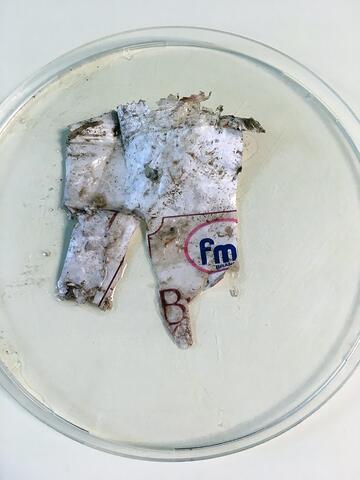Understanding how marine contaminants move through the food web to increase knowledge about fish behaviour and biology and inform decisions about food security
Marine predators such as tuna are at the top of the food web with relatively long-life cycles. These species are particularly exposed to chemical contaminants such as mercury (naturally occurring or anthropogenic), plastic particles, persistent organic pollutants (POPs) such as pesticides used in conventional agriculture, and other contaminants. As these contaminants accumulate in the body fat of organisms, they become more concentrated as you move up the food chain, from smaller species to larger species. These contaminants can also be used as tracers to better understand the biology and behaviour of top predators.

POPs do not degrade and persist in the environment. They enter the water system via waste channels or surface runoff for example, and end-up in the sea. Those pollutants can be transported long distances. Once in the water, they can be ingested by organisms where they accumulate and are not excreted. This build-up of POPs in an organism can induce toxic effects, affecting the reproductive or nervous system for example.
Plastics have become abundant in all oceans due to their high usage by human populations and lack of appropriate waste management. Plastic waste in the oceans is made of macro-plastics, such as bottles and bags, and micro-plastics (<5mm) coming from the fragmentation of macro-plastics. Moreover, additives such as phthalates and bisphenol A are included in the plastics when manufactured so they acquire specific properties like colour or heat-resistance, for example. These additives, making-up more than half of the weight of the plastic, are toxic and can be dispersed in the environment or in organisms that have consumed floating plastic while foraging.
Mercury is emitted into the atmosphere through natural sources such as volcanoes, but more extensively through human activities such as burning coal and fossil fuels, industrial waste, and small-scale gold mining. The gaseous form of mercury in the atmosphere is gradually deposited into the oceans in the form of dissolved mercury, or methylmercury. This methylmercury is highly bioavailable for ingestion and fixation by the organisms at the base of the food web. Its concentration increases naturally, by accumulation, because it is only eliminated in very small quantities by organisms, from the very first stages in the food web (plankton), up to the top predators (tuna and sharks), which contain the highest methylmercury levels.
Consumption of seafood is the main pathway humans are exposed to contaminants such as mercury and POPs. In a region such as the Pacific where a number of populations depend on seafood for nutrition, we need to understand what are the implications for human health.
Based on samples from the Pacific Marine Specimen Bank, research on various contaminants can be conducted at a large spatial scale and through time to understand when contamination started, if any, and how it is spatially distributed. Acquiring this knowledge is crucial for making decisions on food security for the populations of the Pacific.
